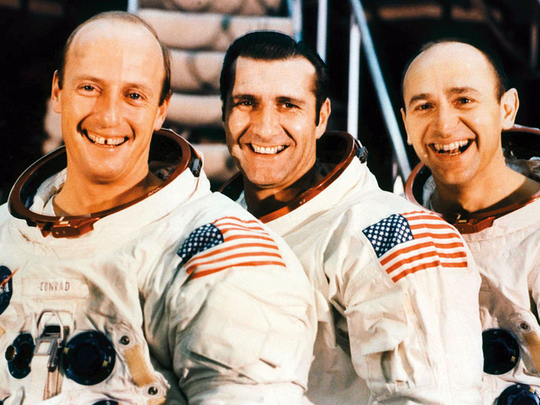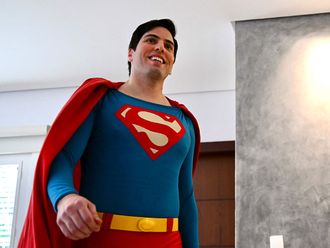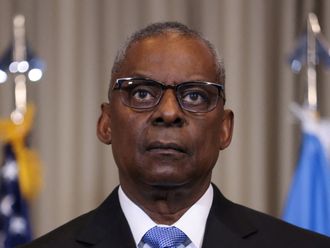
Washington: Alan Bean, who became the fourth man to walk on the moon and turned to painting years later to tell the story of NASA’s Apollo missions as they began receding into history, died Saturday at Houston Methodist Hospital. He was 86.
His death was announced by his family in a statement released by Nasa.
Bean stepped onto the lunar surface preceded by Pete Conrad, the mission commander of their Apollo 12 flight, in November 1969, four months after Neil Armstrong and Buzz Aldrin became the first lunar explorers.
The flight of Apollo 12, while thrilling in its own right, was not nearly as dramatic as the pioneering mission of Apollo 11, but it resulted in a more extensive exploration of the moon.
Bean returned to space in July 1973, when he commanded a three-man flight to the orbiting space research station Skylab, the forerunner of the International Space Station. The astronauts on that mission spent 59 days in space, a record at the time.
Twelve astronauts ultimately walked on the moon in six Apollo missions. When Bean, a former Navy test pilot, left Nasa in 1981, he drew on a long-standing interest in painting to become a full-time artist, creating images of the era when science fiction morphed into reality.
Many of Bean’s fellow astronauts were evidently taken aback by his choosing the art world over private business. “I’d say 60 per cent of them thought maybe I was having a midlife crisis,” Bean recalled in his book “Apollo” (1998), written with Andrew Chaikin, in which he reproduced many of his paintings.
“Every artist has the earth or their imaginations to inspire their paintings,” Bean told The New York Times in 1994. “I’ve got the earth and my imagination, and I’m the first to have the moon, too.”
Bean’s paintings drew on his recollections, interviews with fellow astronauts, photos and videos. They included a re-creation of Armstrong securing an American flag in the lunar dust; Bean standing alongside Conrad on the moon, looking toward earth; Eugene A. Cernan riding in a lunar rover during the Apollo 17 mission and the earth rising above the moon.
Working from his home in Houston, Bean strove for accuracy in presenting the astronauts’ gear and the prevailing light, but his paintings often conveyed a sense of what it was like to work on the moon rather than replicating an exact moment. He employed colour liberally in place of the black, grey and white of the lunar terrain and the skies.
About 45 of Bean’s paintings were displayed at the Smithsonian National Air and Space Museum in Washington in an exhibition marking the 40th anniversary of the first moon walk. Bean sold his paintings on his website and had fetched as much as $175,000 for a single painting by then, although he had received limited attention from critics, The Times reported.
“There is an evident sincerity, diligence and restraint, coupled with a momentous subject that the artist clearly knows intimately, but he does not exploit or sensationalise,” Roberta Smith wrote in The Times in June 2009, in a review of the paintings on Bean’s website.
“But except for a painting of the earth viewed from the moon, the website’s offerings are all the same,” she added. “This indicates yet another artist working from a formula, which can make his efforts seem commercial and risk-averse.”
Alan LaVern Bean was born on March 15, 1932, in Wheeler, Texas, but grew up in Fort Worth. He was fascinated by model planes as a youngster and received a bachelor’s degree in aeronautical engineering in 1955 from the University of Texas.
He obtained a commission in Navy aviation and after completing test-pilot school was selected by Nasa as one of 14 new astronauts in October 1963. But it wasn’t until Apollo 12 that he flew in space.
Seconds after the capsule’s lift-off, a lightning strike knocked out its electrical equipment, but its power was quickly restored. Bean and Conrad made a pinpoint landing on terrain called the Ocean of Storms, having descended in their lunar module from the capsule being flown in orbit by a third astronaut, Richard Gordon.
They spent about 7 hours and 45 minutes completing two moonwalks in which they deployed instruments to study the moon’s geology, installed a nuclear generator to power future experimental equipment and collected an extensive assortment of moon rocks.
They also reached Surveyor 3, an unmanned lunar probe that had flown to the moon 31 months earlier, and cut away pieces of it so Nasa could examine the moon’s impact on its materials.
The three astronauts, all holding the rank of Navy commander, splashed down in the Pacific Ocean only 3 miles from the aircraft carrier Hornet. All were promoted by President Richard M. Nixon to the rank of captain.
Conrad died in a motorcycle accident in 1999; Gordon died in 2017.
Bean later commanded the second of three flights to the Skylab orbiting laboratory, working with Jack R. Lousma of the Marine Corps and Owen K. Garriott, a scientist-astronaut, on a mission that studied the earth’s make-up and the sun’s atmosphere.
He retired from the Navy in 1975 but remained with Nasa for another six years, overseeing the training of future astronauts.
He is survived by his second wife, Leslie; and by a son, Clay, and a daughter, Amy Sue, from his marriage to his first wife, Sue; and by a sister, Paula Stott.
— New York Times News Service












